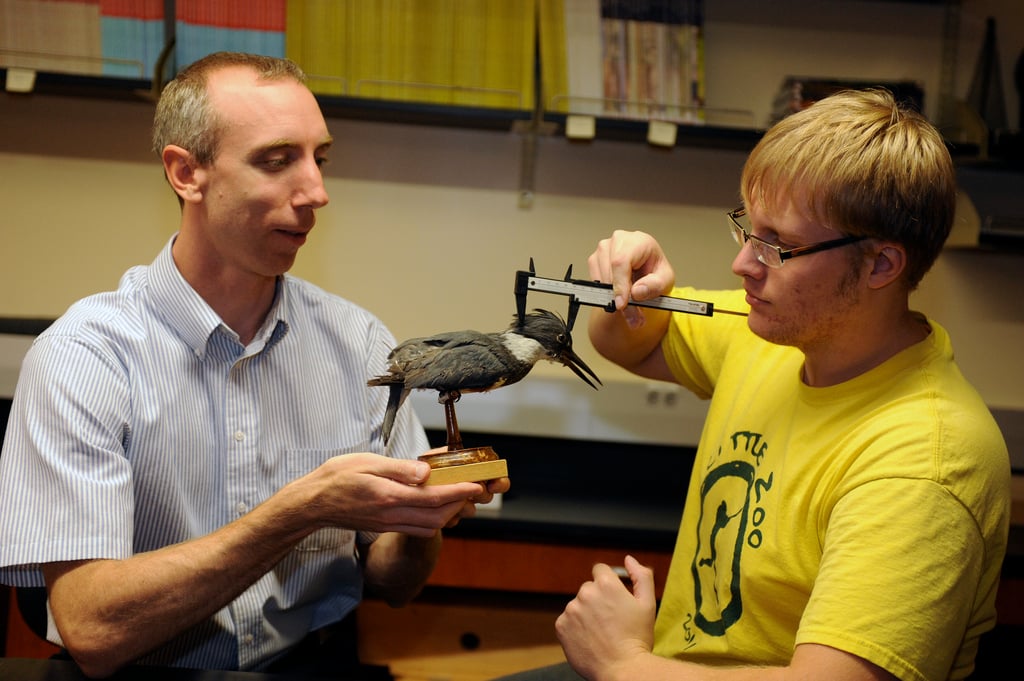I will write about writing this week. I am on sabbatical and finding plenty of time to “write.” I put that word in quotes because not all writing is actual writing. Obviously, I write with the aid of a computer, and for me, the amount of text on the screen at the end of the day may not be much more than what was there in the beginning. Writing is a slow process. I can type a lot faster than I can write! Confused? If so, maybe I should re-write this paragraph to make it clearer. But that will take too long. Like I said: slow.
Home Range Paper
One paper I have been working on is a scientific research article on home range use by Downy Woodpeckers. The main questions I am investigating are:
- How much acreage does a single woodpecker use, on average?
- Does this amount of acreage change over time with the seasons?
- Do males and females share space more so than birds of the same gender?
I started my sabbatical with a manuscript on these questions already half-written. It was 8 pages in length in January. Now, midway through February it is still 8 pages. Does this mean I have made no progress? Not necessarily. I have revised what I started with, and then revised it again. I changed the storyline several times and I am not sure I like where it is heading right now. I will probably change it again.
If I am working on a scientific paper, why should I worry about a storyline? In every piece of writing—scientific or not—the author is writing a story. It’s an artistic endeavor. In my case, I have to introduce my topic, tell why it is important, propose some ideas and then test to see if my ideas are supported by the facts. The “story” in this case is how I capture the reader’s interest and take them through my thought process to where I explain the actual scientific methods used to collect data on woodpecker behavior.
My work on woodpeckers is unlikely to improve human health or commerce. Unless you are naturally curious about birds, you may not find my research interesting. That’s fine, and even most scientists encountering my writing might pass right over it in favor of something more interesting to them. My challenge, therefore, is to make my paper sound as interesting as possible—to weave a story that combines threads of information from one topic with another and another until I have justified my scientific investigation. The more threads I draw together in a convincing way, the more interesting my work will be to the readers, who each come with their own scientific interests and biases.
I keep re-writing the home range paper. Each time I modify it, I use a different set of threads in the hope that my story comes alive and my beloved woodpeckers will get a little extra appreciation and publicity. My goal in studying woodpeckers is simply to add to our knowledge base about them. It’s an entirely reasonable and honorable goal, but the reality is my work will not get published unless it is interesting to the readership of a journal.
The task of “writing” also involves quite a bit of reading. I have done a lot more reading about home ranges and ways to analyze them than actually writing my paper. The only way to publish this work is to be an expert in the field. The only way to be an expert is to know what everyone else is doing and what they have found. Only then can I find the threads that will make my own work useful to them.
Swimming Paper
There is a second paper I am working on. I admit to being more enthusiastic about it than the woodpecker article, even though this second paper will not be published in the scientific literature. Instead, I am targeting a swimming magazine.
That’s right. They actually write whole magazines on swimming!
I am not an expert in swimming. I took lessons when I was very young but was never confident in the water. At Boy Scout summer camp, I always failed the swimming test and was restricted to the shallow part of the lake. Many years later in 2008, Michael Phelps had an inspiring performance at the Olympic Games and I decided that swimming looked like fun. I called upon Saint Vincent Head Swimming Coach Josh Gurekovich in 2009 and he taught me to swim. It was fun, and in late 2010 I started competing on a YMCA team in Greensburg. I might sound like an expert in swimming, but it is a very technical sport and I’m nowhere close to being an expert.
So why do I think I can get something published in a swimming magazine?
Answer: I’ve got a good storyline.
My article will weave two different threads together to grab the interest of swimmers, bird enthusiasts, and any bird enthusiasts that happen to swim (I know of at least one!).
My article will first discuss animals that swim (fish, sea turtles, marine mammals) and compare their swimming to how humans swim. I will then use video footage someone captured of a “swimming owl” to bring birds into the discussion.

All birds swim; not just the owl in the video, and not just penguins and diving birds. I mean all birds, even the woodpeckers! Air and water are both fluids in a physical sense, and fish that swim and birds that fly are simply moving their bodies around in certain ways to generate forces to propel them forward. I will finish my article discussing how the wing movements of birds are similar to what human swimmers do with their arms while doing the butterfly stroke (see photo). Further, I’ll talk about how butterflies fly since the swimming stroke is named for them. Is there any biological reason for naming a swim stroke after an insect? You’ll just have to read my article when I’m finished.
I’m not yet done. However, writing the article has already been useful to me as both a swimmer and a biologist. In doing research for this article, I have learned things that I can now teach students in my Ornithology and Wildlife Biology courses. For example:
- I have learned how insects, including butterflies, generate lift and thrust when they fly. Frankly, I am surprised how similar insect flight is to bird flight.
- I have learned how fast sea turtles swim. The fastest leatherback sea turtle ever recorded swam at 6.3 miles per hour (mph), which is 33% slower than Michael Phelps. Plus, the turtle could only sustain that speed for 20 seconds. Mr. Phelps has more endurance.
- I have learned how whales and fish propel themselves through the water by simple back-and-forth motions of the tail. Sure, I knew they could do this, but now I know how.
- I learned that the barracuda fish really doesn’t eat people. I guess it took 30 years for me to realize this was a boyhood myth.
- I learned that David Armbruster, a swim coach at the University of Florida, is credited with a 1934 modification to the breaststroke that featured out-of-water arm motions. He coined this move the butterfly stroke. Does it strike anyone else that “Armbruster” could easily be changed to “Arm-Buster” and then it would be ironic that he created a swimming stroke that required great arm strength? Oh, never mind. I’ll leave that out of the article.
- I have learned how fast butterflies fly, and how much distance they can cover over the course of a day when on migration. That’s 264 miles. That works out to 11 mph.
- I have learned how fast birds fly, and of course this varies depending on the size of the bird and the shape of its wing. Typical speeds of small birds like woodpeckers are 25-35 mph, but as I said, it varies a lot.
- I learned that bird wings held at an angle while flapping not only create lift to keep them in the air, but they also create forward motion. I had not previously known this application of the Bernoulli Principle. I probably should have. In fact, I will be revising my Ornithology class lesson about flight to account for this.
- I have learned why helicopters have that extra little propeller on the tail. It helps change the angle of the main propeller to produce more or less forward motion.
Oh, see…that last little detail won’t make it into my article. But such is the process of writing. Not all of what you write gets into the finished product.
I do believe I will finish both of the papers I am working on by the end of my sabbatical. However, it may take the entire sabbatical to finish this work. I am slow. But that’s ok. We can’t all fly like birds. Some of us just plod along and swim like sea turtles in the ocean, or fly like monarch butterflies on migration. We eventually all get to where we are going.


 中国学生
中国学生 Estudiantes
Estudiantes




